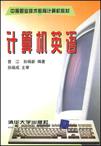计算机英语
2001-1
清华大学
曾江,孙瑞新
245
当今世界,计算机、通信、微电子和软件技术的发展和应用已成为衡量一个国家现代化程度的主要标志之一。 随着我国改革开放的进一步深入,目前全国各地职业高中及各类中专的各专业相继都开设了计算机课,它标志着我国职业高中、中专的计算机教育、教学已进入一个新的发展阶段。 学习计算机,一要学什么是计算机,二要学计算机的操作,学习内容包括理论和实践操作。计算机是一门应用型学科,操作性强。随着计算机在社会各个领域的应用越来越广泛,对计算机操作能力的要求也越来越高。所以,职业高中、中专各专业都在开设计算机课。计算机课的教学要面向社会、面向市场,既要让学生学习计算机知识,又要对学生进行计算机操作技能的训练,重点是侧重操作和技能性方面的训练。 选好教材、用好教材是搞好计算机教学的重要保证。出版一套适合各类职业高中、中专各专业适用的系列教材,就是我们编写这套教材的初衷。 根据职业高中、中专各专业计算机教学的特点,这套教材在注重系统性、科学性的基础上重点突出了实用性和操作性,重点讲述计算机的基本概念和基本操作方法。按照由浅入深的教学原则,把各册教材的内容分割成若干个模块,采取循序渐进的教学方法,力求通俗而不肤浅,深入而不玄奥。各部分都采用举实例的方法讲述操作技术;对重点概念、重要的操作技能,力争讲深讲透。 侧重上机操作,将上机指导作为主要内容之一是本教材的又一特色。每章后的上机指导内容通俗易懂,操作循序渐进。每个上机指导包括目的与要求、软硬件环境和操作步骤三部分。有些操作练习有详细的参考步骤,其目的是为了举一反三;有些操作练习没有参考步骤,其目的是为了使学生进一步巩固所学知识和掌握操作方法。每章的上机指导配合小结、习题,使学生在动脑、动手的过程中牢固地掌握计算机实用技术。 本套教材的作者均为从事计算机教育10年以上的计算机高级教师,来自全国部分职业高中计算机专业及非计算机专业计算机教学的第一线,有丰富的计算机教育、教学经验,并出版过多本计算机教育的书籍。本套教材均为中等职业教育中急需的计算机教材。通过本套教材的学习,学生可以掌握计算机专业基础知识和技术,较熟练地掌握计算机的使用和维护技能,并具有初步的程序设计能力。对教材内容中不妥或需要改进之处,殷切希望广大师生向我们指出,以便再版时修改和补充。来信请寄:北京清华大学出版社编辑部(100084)。 这套教材编写的内容对社会上人事部门、劳动部门的技术等级考试也具有指导作用。
本书内容实用、新颖,具有一定的超前性,课文取材于英语原版书刊、使用说明书和软件在线帮助,内容丰富,覆盖了硬件、软件、因特网和面向21世纪的计算机新技术和新应用。硬件方面介绍了CPU、存储器标准、打印机、数码相机、各种定点设备、新型显示设备、调制解调器、华硕P3B主板;软件方面介绍了Windows、主存数据库、网络操作系统、两个FoxPro命令、千年虫;因特网方面介绍了因特网编程语言、因特网传真、因特网接入技术、因特网安全;计算机新技术和新应用方面介绍了语音识别、虚拟现实、IPv6协议、内容过滤、数字钱包、MP3、数字包装器、IP话音传输、Java、下一代输入/输出结构、下一代Web语言,给出了60余个常见术语。 书中的难点通过注释形式帮助读者理解,每课后列出本课的关键词及复习题,书后附有参考译文,供读者对照,理解原文。 通过本课程的学习,可掌握一定数量的计算机专业英语词汇,看懂常见的屏幕信息,能初步阅读和理解使用计算机过程中的提示信息和专业说明书等英文资料。 本书适用于中等职业技术学校计算机及相关专业,也可供大专院校和各类培训班学员、计算机操作和应用者选用。
Lesson1 PCs In 19Lesson2 The Central Processing UnitLesson3 Universal Serial BusLesson4 Mice and other Pointing DevicesLesson5 The Memory StandardsLesson6 Digital CamerasLesson7 New Display Technologies (1)Lesson8 New Display Technologies (2)Lesson9 The Standard of 56K ModemLesson10 PrintersLesson11 Network Operating Systems Lesson12 Windows SeriesLesson13 Main Memory DatabaseLesson14 CREATE and DISPLAYLesson15 Year 2000: lt's Also A Network ProblemLesson16 Myths About the InternetLesson17 Programming Languages for InternetLesson18 The ExtranetLesson19 Network and Distributed OSsLesson20 Internet FaxLesson21 VPNs (1)Lesson22 VPNs (2)Lesson23 Remote Access Technologies——Modem、ISDN、DSL and Cable ModemLesson24 High\|Speed Access Technologies——Modems、ISDN、Cable Modems and DSLLesson25 Internet Security (1)Lesson26 Internet Security (2)Lesson27 Voice RecognitionLesson28 Virtual RealityLesson29 IPv6 ProtocolLesson30 Content FilteringLesson31 Digital WalletsLesson32 Features of the ASUS P3B\|F Motherboard Lesson33 MP3?Lesson34 Digital WrappersLesson35 Voice Over IP(VOIP)Lesson36 Input/Output ArchitectureLesson37 JavaLesson38 XML: Web Language (1)Lesson39 XML: Web Language (2)Lesson40 Special Terms参考译文 第1课 1999年的PC机 第2课 中央处理单元(CPU) 第3课 通用串行总线 第4课 鼠标和其他定点设备 第5课 存储器标准 第6课 数码相机 第7课 显示新技术(1) 第8课 显示新技术(2) 第9课 56K调制解调器标准 第10课 打印机 第11课 网络操作系统 第12课 Windows系列 第13课 主存数据库 第14课 CREATE和DISPLAY命令 第15课 2000年:同样是网络问题 第16课 因特网的神话 第17课 Internet程序设计语言 第18课 企业外部网 第19课 网络与分布式操作系统 第20课 因特网传真 第21课 虚拟专用网(1) 第22课 虚拟专用网(2) 第23课 远程接入技术——modem、ISDN、DSL和Cable modem(1) 第24课 高速接入技术——modem、ISND、Cable modem和DSL 第25课 因特网安全(1) 第26课 因特网安全(2) 第27课 语音识别 第28课 虚拟现实 第29课 IPv6协议 第30课 内容过滤 第31课 数字钱夹 第32课 华硕P3B?F主板特性 第33课 MP3? 第34课 数字包装器 第35课 IP话音传输 第36课 输入输出结构 第37课 Java 第38课 XML:Web语言(1) 第39课 XML:Web语言(2) 第40课 常用术语各课练习参考答案总词汇表
The future of display technology can be summed up in two words: displayseverywhere. As you stroll through the world of the 21st century, you ll encounterdisplays in all sorts of places. In addition to the displays on your desktop and notebookcomputers, you will also find color displays on your cellular phone, in your car, incameras, built into games and toys and throughout your home. Large, high-definition TV (HDTV) displays, naturally, will dominate the livingroom, but there will also be displays hanging along walls, like picture frames availableto display whatever you choose, At the small end of the scale, there will be displays onhandheld devices, pagers and appliances. Even your alarm clock or kitchen coffeemachine may feature a colorful display that shows the E-mail that arrived overnight. On your desktop in the office, though, trusty CRT technology will prevail.Nothing on the horizon looks likely to replace the desktop CRT anytime soon on thebasis of display size, resolution and, particularly, price. Nor is CRT technology standing still. Sony Electronics, for instance, isusing tungsten infused cathodes in its "wide-aspect displays" to double the beam densityof ordinary cathodes. By reducing the beam spot size, it provides 30% more screen realestate with no added footprint, says Sony, translating into more potential windows onscreen. As organizations work to develop flatter CRTs, the footprint of the CRT willcontinue to shrink. People are looking at a range of novel ways to make flat-paneldisplays. For example, edge-emitting CRTs fire off electrons parallel to the displayscreen rather than directly at it, allowing for flatter displays. The electrons must thenbe deflected to hit the correct pixels. This technology works, at least for small displayswith diagonals of about four inches or less, but it remains to be seen if it can scale up tothe larger size screens desktop users are demanding today.
《中等职业技术教育计算机教材:计算机英语》适用于中等职业技术学校计算机及相关专业,也可供大专院校和各类培训班学员、计算机操作和应用者选用。
